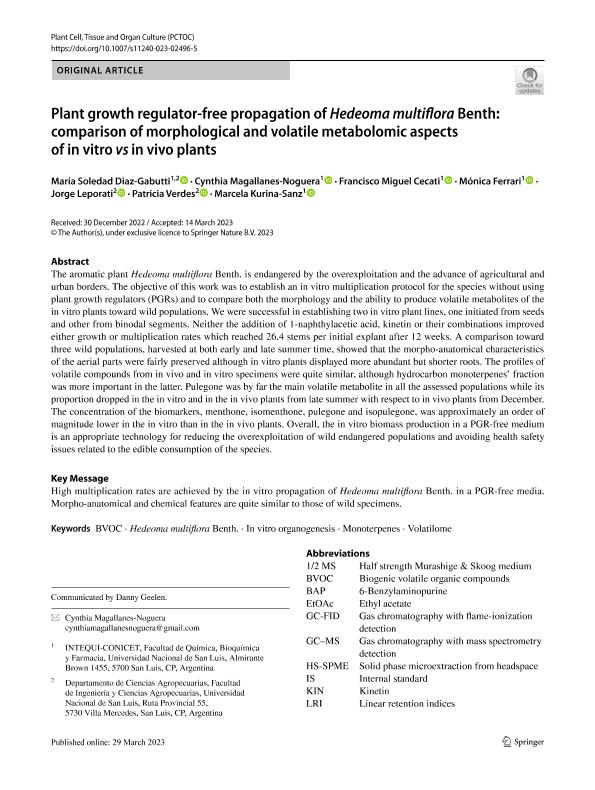Mostrar el registro sencillo del ítem
dc.contributor.author
Diaz Gabutti, Maria Soledad

dc.contributor.author
Magallanes Noguera, Cynthia Alejandra

dc.contributor.author
Cecati, Francisco Miguel

dc.contributor.author
Ferrari, Monica Marta

dc.contributor.author
Leporati, Jorge Leandro

dc.contributor.author
Verdes, Patricia Estela

dc.contributor.author
Kurina Sanz, Marcela Beatriz

dc.date.available
2024-02-19T12:30:10Z
dc.date.issued
2023-03
dc.identifier.citation
Diaz Gabutti, Maria Soledad; Magallanes Noguera, Cynthia Alejandra; Cecati, Francisco Miguel; Ferrari, Monica Marta; Leporati, Jorge Leandro; et al.; Plant growth regulator-free propagation of Hedeoma multiflora Benth: comparison of morphological and volatile metabolomic aspects of in vitro vs in vivo plants; Springer; Plant Cell, Tissue and Organ Culture; 153; 3; 3-2023; 587-598
dc.identifier.issn
0167-6857
dc.identifier.uri
http://hdl.handle.net/11336/227387
dc.description.abstract
The aromatic plant Hedeoma multiflora Benth. is endangered by the overexploitation and the advance of agricultural and urban borders. The objective of this work was to establish an in vitro multiplication protocol for the species without using plant growth regulators (PGRs) and to compare both the morphology and the ability to produce volatile metabolites of the in vitro plants toward wild populations. We were successful in establishing two in vitro plant lines, one initiated from seeds and other from binodal segments. Neither the addition of 1-naphthylacetic acid, kinetin or their combinations improved either growth or multiplication rates which reached 26.4 stems per initial explant after 12 weeks. A comparison toward three wild populations, harvested at both early and late summer time, showed that the morpho-anatomical characteristics of the aerial parts were fairly preserved although in vitro plants displayed more abundant but shorter roots. The profiles of volatile compounds from in vivo and in vitro specimens were quite similar, although hydrocarbon monoterpenes’ fraction was more important in the latter. Pulegone was by far the main volatile metabolite in all the assessed populations while its proportion dropped in the in vitro and in the in vivo plants from late summer with respect to in vivo plants from December. The concentration of the biomarkers, menthone, isomenthone, pulegone and isopulegone, was approximately an order of magnitude lower in the in vitro than in the in vivo plants. Overall, the in vitro biomass production in a PGR-free medium is an appropriate technology for reducing the overexploitation of wild endangered populations and avoiding health safety issues related to the edible consumption of the species.
dc.format
application/pdf
dc.language.iso
eng
dc.publisher
Springer

dc.rights
info:eu-repo/semantics/openAccess
dc.rights.uri
https://creativecommons.org/licenses/by-nc-sa/2.5/ar/
dc.subject
BVOC
dc.subject
HEDEOMA MULTIFLORA BENTH
dc.subject
IN VITRO ORGANOGENESIS
dc.subject
MONOTERPENES
dc.subject
VOLATILOME
dc.subject.classification
Otras Ciencias Biológicas

dc.subject.classification
Ciencias Biológicas

dc.subject.classification
CIENCIAS NATURALES Y EXACTAS

dc.title
Plant growth regulator-free propagation of Hedeoma multiflora Benth: comparison of morphological and volatile metabolomic aspects of in vitro vs in vivo plants
dc.type
info:eu-repo/semantics/article
dc.type
info:ar-repo/semantics/artículo
dc.type
info:eu-repo/semantics/publishedVersion
dc.date.updated
2024-02-19T10:42:21Z
dc.journal.volume
153
dc.journal.number
3
dc.journal.pagination
587-598
dc.journal.pais
Alemania

dc.description.fil
Fil: Diaz Gabutti, Maria Soledad. Consejo Nacional de Investigaciones Científicas y Técnicas. Centro Científico Tecnológico Conicet - San Luis. Instituto Multidisciplinario de Investigaciones Biológicas de San Luis. Universidad Nacional de San Luis. Facultad de Ciencias Físico Matemáticas y Naturales. Instituto Multidisciplinario de Investigaciones Biológicas de San Luis; Argentina
dc.description.fil
Fil: Magallanes Noguera, Cynthia Alejandra. Universidad Nacional de San Luis; Argentina. Consejo Nacional de Investigaciones Científicas y Técnicas. Centro Científico Tecnológico Conicet - San Luis. Instituto de Investigaciones en Tecnología Química. Universidad Nacional de San Luis. Facultad de Química, Bioquímica y Farmacia. Instituto de Investigaciones en Tecnología Química; Argentina
dc.description.fil
Fil: Cecati, Francisco Miguel. Universidad Nacional de San Luis; Argentina. Consejo Nacional de Investigaciones Científicas y Técnicas. Centro Científico Tecnológico Conicet - San Luis. Instituto de Investigaciones en Tecnología Química. Universidad Nacional de San Luis. Facultad de Química, Bioquímica y Farmacia. Instituto de Investigaciones en Tecnología Química; Argentina
dc.description.fil
Fil: Ferrari, Monica Marta. Consejo Nacional de Investigaciones Científicas y Técnicas. Centro Científico Tecnológico Conicet - San Luis. Instituto de Investigaciones en Tecnología Química. Universidad Nacional de San Luis. Facultad de Química, Bioquímica y Farmacia. Instituto de Investigaciones en Tecnología Química; Argentina. Universidad Nacional de San Luis; Argentina
dc.description.fil
Fil: Leporati, Jorge Leandro. Universidad Nacional de San Luis; Argentina
dc.description.fil
Fil: Verdes, Patricia Estela. Universidad Nacional de San Luis; Argentina
dc.description.fil
Fil: Kurina Sanz, Marcela Beatriz. Universidad Nacional de San Luis; Argentina. Consejo Nacional de Investigaciones Científicas y Técnicas. Centro Científico Tecnológico Conicet - San Luis. Instituto de Investigaciones en Tecnología Química. Universidad Nacional de San Luis. Facultad de Química, Bioquímica y Farmacia. Instituto de Investigaciones en Tecnología Química; Argentina
dc.journal.title
Plant Cell, Tissue and Organ Culture

dc.relation.alternativeid
info:eu-repo/semantics/altIdentifier/url/https://link.springer.com/article/10.1007/s11240-023-02496-5
dc.relation.alternativeid
info:eu-repo/semantics/altIdentifier/doi/http://dx.doi.org/10.1007/s11240-023-02496-5
Archivos asociados
